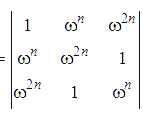Using properties of determinant, If f(x)=a+bx+cx2, prove that ∣∣ ∣∣abcbcacab∣∣ ∣∣=−f(1)f(ω)f(ω2),ω is a cube root of unity
To prove that
∣∣
∣∣abcbcacab∣∣
∣∣=−f(1)f(ω)f(ω2)
where f(x)=a+bx+cx2 and ω is a cube root of unity, we will follow these steps:
Step 1: Define the function f(x)
We start by defining the polynomial function:
f(x)=a+bx+cx2
Step 2: Calculate f(1)
Substituting x=1 into f(x):
f(1)=a+b+c
Step 3: Calculate f(ω)
Next, we substitute x=ω:
f(ω)=a+bω+cω2
Step 4: Calculate f(ω2)
Now substitute x=ω2:
f(ω2)=a+bω2+cω4
Since ω3=1, we have ω4=ω:
f(ω2)=a+bω2+cω
Step 5: Calculate the determinant
We need to compute the determinant:
D=∣∣
∣∣abcbcacab∣∣
∣∣
Using the properties of determinants, we can perform row operations. We add the second and third rows to the first row:
D=∣∣
∣∣a+b+ca+b+ca+b+cbcacab∣∣
∣∣
Step 6: Factor out a+b+c
Now, we can factor out a+b+c from the first row:
D=(a+b+c)∣∣
∣∣111bcacab∣∣
∣∣
Step 7: Simplify the determinant
Now we perform column operations by subtracting the first column from the second and third columns:
D=(a+b+c)∣∣
∣∣100bc−ba−bca−cb−c∣∣
∣∣
This determinant can be simplified further:
D=(a+b+c)((c−b)(b−c)−(a−b)(a−c))
Step 8: Final expression
After simplification, we can express the determinant in terms of f(1),f(ω), and f(ω2):
D=−f(1)f(ω)f(ω2)
Conclusion
Thus, we have shown that
∣∣
∣∣abcbcacab∣∣
∣∣=−f(1)f(ω)f(ω2)
∣∣abcbcacab∣∣
∣∣=−f(1)f(ω)f(ω2)
We start by defining the polynomial function:
Substituting x=1 into f(x):
Next, we substitute x=ω:
Now substitute x=ω2:
We need to compute the determinant:
∣∣abcbcacab∣∣
∣∣
∣∣a+b+ca+b+ca+b+cbcacab∣∣
∣∣
Now, we can factor out a+b+c from the first row:
∣∣111bcacab∣∣
∣∣
Now we perform column operations by subtracting the first column from the second and third columns:
∣∣100bc−ba−bca−cb−c∣∣
∣∣
After simplification, we can express the determinant in terms of f(1),f(ω), and f(ω2):
Thus, we have shown that
∣∣abcbcacab∣∣
∣∣=−f(1)f(ω)f(ω2)
Topper's Solved these Questions
- MODEL TEST PAPER-5BOOK - ICSECHAPTER - MODEL TEST PAPER-5EXERCISE - Section-B
10 Videos
- MODEL TEST PAPER-5BOOK - ICSECHAPTER - MODEL TEST PAPER-5EXERCISE - Section -C
10 Videos
- MODEL TEST PAPER-16BOOK - ICSECHAPTER - MODEL TEST PAPER-16EXERCISE - SECTION -C (65 MARKS)
10 Videos
- MODEL TEST PAPER-6BOOK - ICSECHAPTER - MODEL TEST PAPER-6EXERCISE - Section -C
10 Videos
Similar Questions
If ω is a cube root of unity, then
1+ω= …..
View SolutionIf a,b,c are real numbers, prove that ∣∣ ∣∣abcbcacab∣∣ ∣∣=−(a+b+c)(c+bw+cw2)(a+bw2+cw), where w is a complex cube root of unity.
View SolutionIf ω is a cube root of unity, then
1+ω2= …..
View SolutionEvaluate ∣∣ ∣ ∣∣1ωω2ωω21ω2ωω∣∣ ∣ ∣∣ where ω is cube root of unity.
View SolutionProve that the value of determinant ∣∣ ∣ ∣∣1ωω2ωω21ω21ω∣∣ ∣ ∣∣=0
where ω is complex cube root of unity .
View SolutionIf ω is a cube root of unity, then
ω+ω2=…..
View SolutionIf f(x)=a+bx+cx2 where a,b,c∈R then ∫1of(x)dx
View SolutionIf 1,ω,ω2 are the cube roots of unity, then △

is equal to.....
View SolutionIf 1, ωandω2 are the cube roots of unity, prove that a+bω+cω2c+aω+bω2=ω2
View SolutionIf ω is an imaginary cube root of unity, then the value of ∣∣ ∣ ∣∣abω2aωbωcbω2cω2aωc∣∣ ∣ ∣∣, is
View Solution
